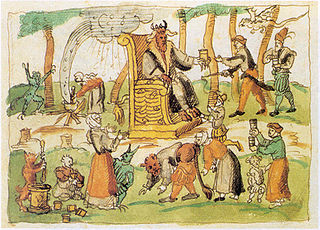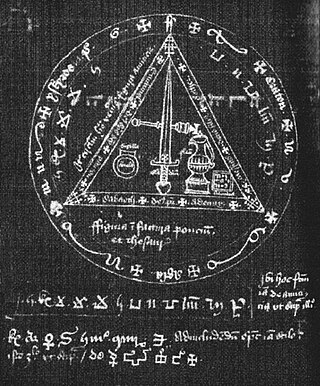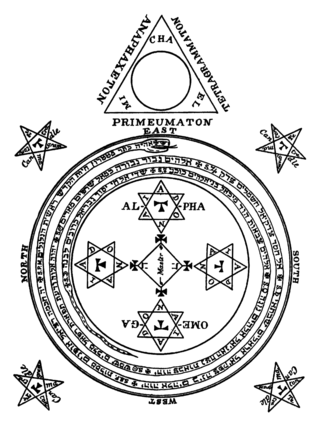
A grimoire is a textbook of magic, typically including instructions on how to create magical objects like talismans and amulets, how to perform magical spells, charms, and divination, and how to summon or invoke supernatural entities such as angels, spirits, deities, and demons. In many cases, the books themselves are believed to be imbued with magical powers, although in many cultures, other sacred texts that are not grimoires have been believed to have supernatural properties intrinsically. The only contents found in a grimoire would be information on spells, rituals, the preparation of magical tools, and lists of ingredients and their magical correspondences. In this manner, while all books on magic could be thought of as grimoires, not all magical books should be thought of as grimoires.

Witchcraft, as traditionally and most commonly understood, is practice of magic, as perceived by historical and present-day communities, directed at harming or inflicting misfortune on others. A practitioner of witchcraft is a witch. The belief in witchcraft as a supernatural conception has been found in "a great number of societies" worldwide, and the practice is generally associated with evil. Anthropologists have applied the English term "witchcraft" to similar and related beliefs in occult practices in many different cultures, and societies that have adopted the English language have often internalised the term.

Magic, sometimes spelled magick, is an ancient practice rooted in rituals, spiritual divinations, and/or cultural lineage—with an intention to invoke, manipulate, or otherwise manifest supernatural forces, beings, or entities in the natural world. It is a categorical yet often ambiguous term which has been used to refer to a wide variety of beliefs and practices, frequently considered separate from both religion and science.

Necromancy is the practice of magical sorcery involving communication with the dead by summoning their spirits as apparitions or visions for the purpose of divination; imparting the means to foretell future events; and discovery of hidden knowledge. Sometimes categorized under death magic, the term is occasionally also used in a more general sense to refer to black magic or witchcraft as a whole. In fictional settings such as Dungeons and Dragons or fantasy video games it is associated with the reanimation of corpses often meant to be used as weapons.
Christian views on magic vary widely among Christian denominations and among individuals. Many Christians actively condemn magic as satanic, holding that it opens the way for demonic possession. Some Christians simply view it as entertainment. Conversely, some branches of esoteric Christianity actively engage in magical practices.
Chaos magic, also spelled chaos magick, is a modern tradition of magic. Emerging in England in the 1970s as part of the wider neo-pagan and esotericist subculture, it drew heavily from the occult beliefs of artist Austin Osman Spare, expressed several decades earlier. It has been characterised as an invented religion, with some commentators drawing similarities between the movement and Discordianism. Magical organizations within this tradition include the Illuminates of Thanateros and Thee Temple ov Psychick Youth.

Black magic, also known as dark magic, has traditionally referred to the use of supernatural powers or magic for evil and selfish purposes, specifically the seven magical arts prohibited by canon law, as expounded by Johannes Hartlieb in 1456.

A Witches' Sabbath is a purported gathering of those believed to practice witchcraft and other rituals. The phrase became popular in the 20th century.

In classical antiquity, including the Hellenistic world of ancient Greece and ancient Rome, historians and archaeologists view the public and private rituals associated with religion as part of everyday life. Examples of this phenomenon are found in the various state and cult temples, Jewish synagogues, and churches. These were important hubs for ancient peoples, representing a connection between the heavenly realms and the earthly planes. This context of magic has become an academic study, especially in the last twenty years.

There is some evidence that, in addition to being a writing system, runes historically served purposes of magic. This is the case from the earliest epigraphic evidence of the Roman to the Germanic Iron Age, with non-linguistic inscriptions and the alu word. An erilaz appears to have been a person versed in runes, including their magic applications.

In Old Norse, seiðr was a type of magic which was practised in Norse society during the Late Scandinavian Iron Age. The practice of seiðr is believed to be a form of magic which is related to both the telling and the shaping of the future. Connected to the Old Norse religion, its origins are largely unknown, and the practice of it gradually declined after the Christianization of Scandinavia. Accounts of seiðr later made it into sagas and other literary sources, while further evidence of it has been unearthed by archaeologists. Various scholars have debated the nature of seiðr, some of them have argued that it was shamanic in context, involving visionary journeys by its practitioners.
Valerie Irene Jane Flint was a British scholar and historian, specialising in medieval intellectual and cultural history.

The Viking Way: Religion and War in Late Iron Age Scandinavia is an archaeological study of old Norse religion in Late Iron Age-Scandinavia. It was written by the English archaeologist Neil Price, then a professor at the University of Aberdeen, and first published by the Department of Archaeology and Ancient History at Uppsala University in 2002. A revised second edition is due to be published in 2017 by Oxbow Books.

The Archaeology of Ritual and Magic is an archaeological study of the material evidence for ritual and magical practices in Europe, containing a particular emphasis on London and South East England. It was written by the English archaeologist Ralph Merrifield, the former deputy director of the Museum of London, and first published by B.T. Batsford in 1987.

Anglo-Saxon Amulets and Curing Stones is an archaeological study of amulets, talismans and curing stones in the burial record of Anglo-Saxon England. Written by the Australian archaeologist Audrey Meaney, it was published by the company British Archaeological Reports as the 96th monograph in their BAR British Series. Prior to writing the work, Meaney had published several books dealing with Anglo-Saxon burials.

Shamans: Siberian Spirituality and the Western Imagination is a historical study of how westerners have viewed the shamans of Siberia. It was written by the English historian Ronald Hutton, then working at the University of Bristol, and first published by Hambledon and London in 2001. Prior to writing Shamans, Hutton had authored a series of books on such subjects as Early Modern Britain, pre-Christian religion, British folklore and Contemporary Paganism.

Magic, Witchcraft and the Otherworld: An Anthropology is an anthropological study of contemporary Pagan and ceremonial magic groups that practiced magic in London, England, during the 1990s. It was written by English anthropologist Susan Greenwood based upon her doctoral research undertaken at Goldsmiths' College, a part of the University of London, and first published in 2000 by Berg Publishers.

During the Middle Ages, magic took on many forms. Instead of being able to identify one type of magic user, there were many who practiced several types of magic in these times, including monks, priests, physicians, surgeons, midwives, folk healers, and diviners. The practice of “magic” often consisted of using medicinal herbs for healing purposes. Classical medicine entailed magical elements. They would use charms or potions in hopes of driving out a sickness. People had strongly differing opinions as to what magic was, and because of this, it is important to understand all aspects of magic at this time.
The history of magic refers to the entire history of events that from someones' perception were impossible to occur, while from the perspective of another person there is a logical explanation. There is supernatural, ritual, illusion, and dark magic, which some refer to as witchcraft.

Goetia is a type of European sorcery transmitted through grimoires. The term itself derives from the Greek word goes, which originally referred to a "diviner, magician, seer, or healer". Goetia was a derogatory term connoting low magic: specious or fraudulent mageia as opposed to theurgy, which was considered divine magic.















